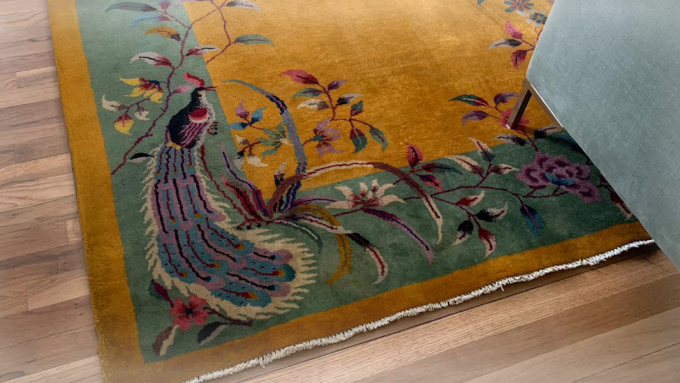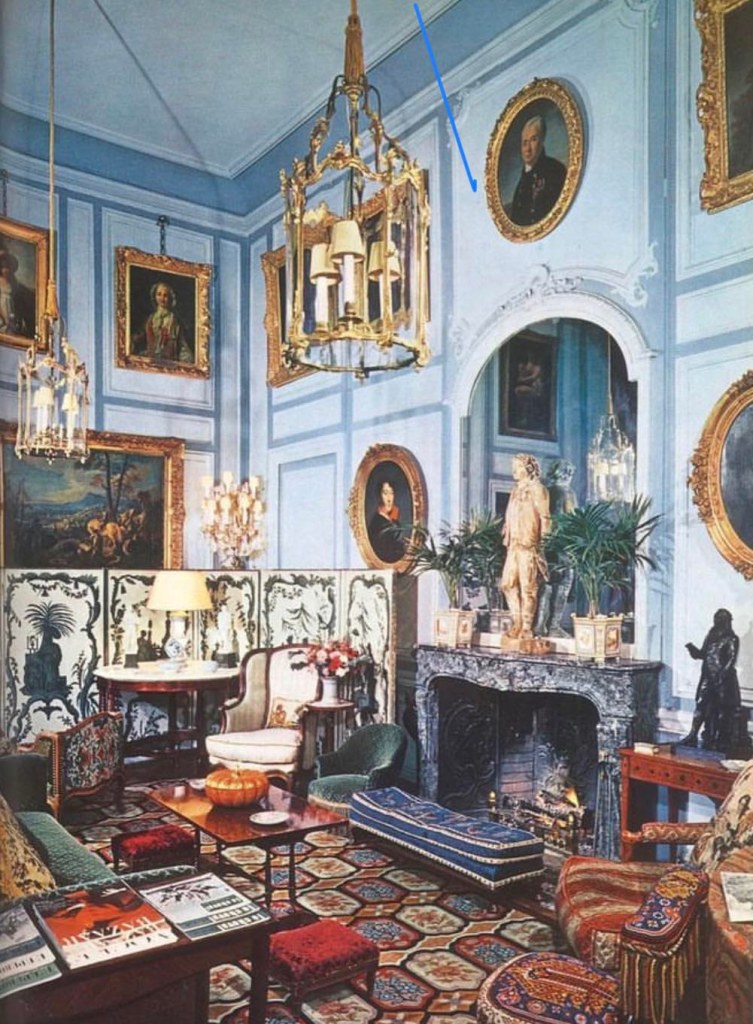In this peacefully happy NYC living space, a saturated yellow ground Chinese Deco carpet with a sage green border lays the base for a seating area that balances the bright and bold energy of pure… More
Blog
The Chinese Carpet Dragon
The dragon is a mythical animal, but you’d never know it from looking at antique Peking Chinese carpets. The Chinese consider the dragon to be a composite of several actual animals: horse, snake, fish, etc. The phoenix, adapted from gold and silver pheasants, and the kylin, with ungulate hooves and flaming leg joints, are among the other popular mythical creatures appearing on Peking Chinese carpets. But the dragon is by far the most popular. Originally emblematic of the emperor and empire, the dragon came to symbolize anything Chinese. Put a proper style dragon on it, the Chinese reference is automatic. Hence a carpet with a dragon appears Chinese. The dragon(s) set the general tone of origin. The notion of the five-claws dragon being imperial and those with fewer having a lower status was, by the nineteenth century, ignored. Every dragon had five claws on each foot. Dragons appear on large carpets, small scatter rugs and chair furnishings. No listing can be complete, but our extensive collection of antique Peking Chinese rugs and carpets provides a uniquely broad conspectus of these dynamic animals.
The Chinese dragon is a benign beast, no matter how fierce it looks. Dwelling primarily in the clouds, it brings rain, so essential to what for millennia was a primarily agrarian economy.
The dragon appears on antique Peking imperial carpets made for the Forbidden City Palaces from at least the late 16th century. Although we do not have one of these, our no. 19737 is a close copy of an early 17th century carpet. The iconography has already been fixed: a full face central dragon, four corner dragons in profile, flaming pearls and clouds scattered about, waves and mountains for a border. The dragon is not intended to be goofy, but the weavers can’t help it.

The five dragon layout can be condensed to antique Chinese chair seat size as displayed on our nos. 22000 and 22074, the latter on a rare dark blue ground. These are Ningxia rather than Peking in origin, but they 8illustrated the basic design protocols. Blue and white is always a popular Chinese color scheme and dragons make it even more exotic, as on 22893.
22079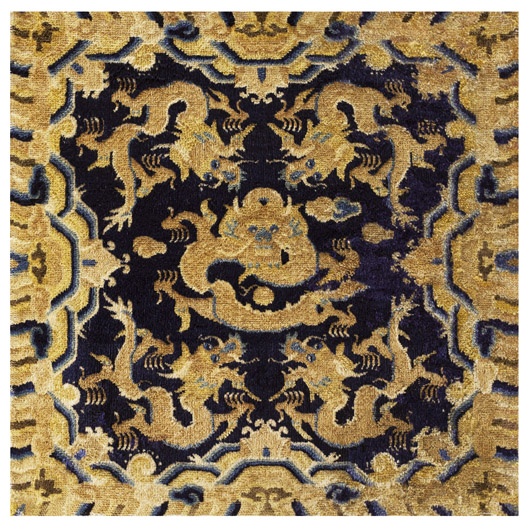
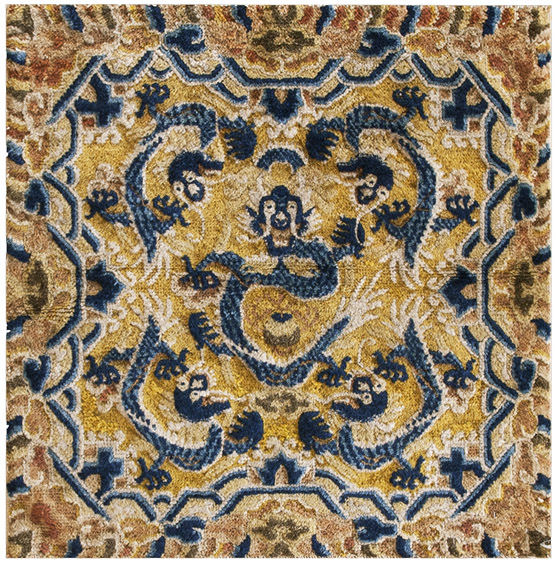
The central dragon may be embedded in a circular medallion while the four corner dragons writhe freely as in our nos. 22297 and 22576.
[illustrations of 22297 and 22576]
The full face central dragon may be replaced by a profile beast, as on our antique Peking carpet #23012 Chinese – Peking 8’0″ x 5’2″
Dragons may share the carpet with phoenixes or actual animals. A phoenix medallion and corner dragons is a popular field layout as on 40-2269. The entire gamut of twelve zodiacal animals may be dominated by a dragon, the only mythical beast, as on a blue and white antique Peking rug no. 22314
[illustrations of 40-2269, 22314]
The usual celestial dragon may be opposed by a rare terrestrial creature wrapped around a needle-like peak as on 22809 and 23144, both blue and white from the same shop and designer.
[illustrations of 22809 and 23144]
A veritable herd of dragons appears in the field and border of the antique Peking rug 22458 with composite foliage dragons in the medallion, corners and border, 14 in all
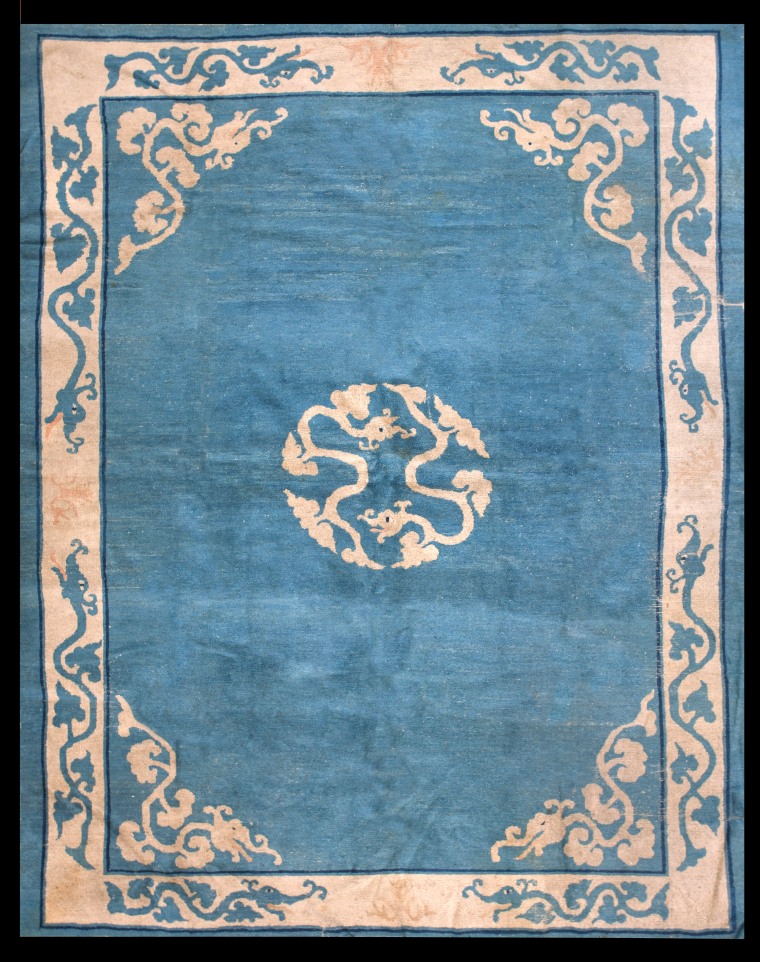
There are a few amusing dragon variants in Peking Chinese antique rugs that cannot escape notice. Three dimensional dragons wrap the border and extend into the field which is centred by a dragon and phoenix medallion in carpet no. 22921. A blue and white carpet (no. 22808) displays eight winged dragons, a Western rather than Chinese conceit.
[illustrations of 22921. 22808]
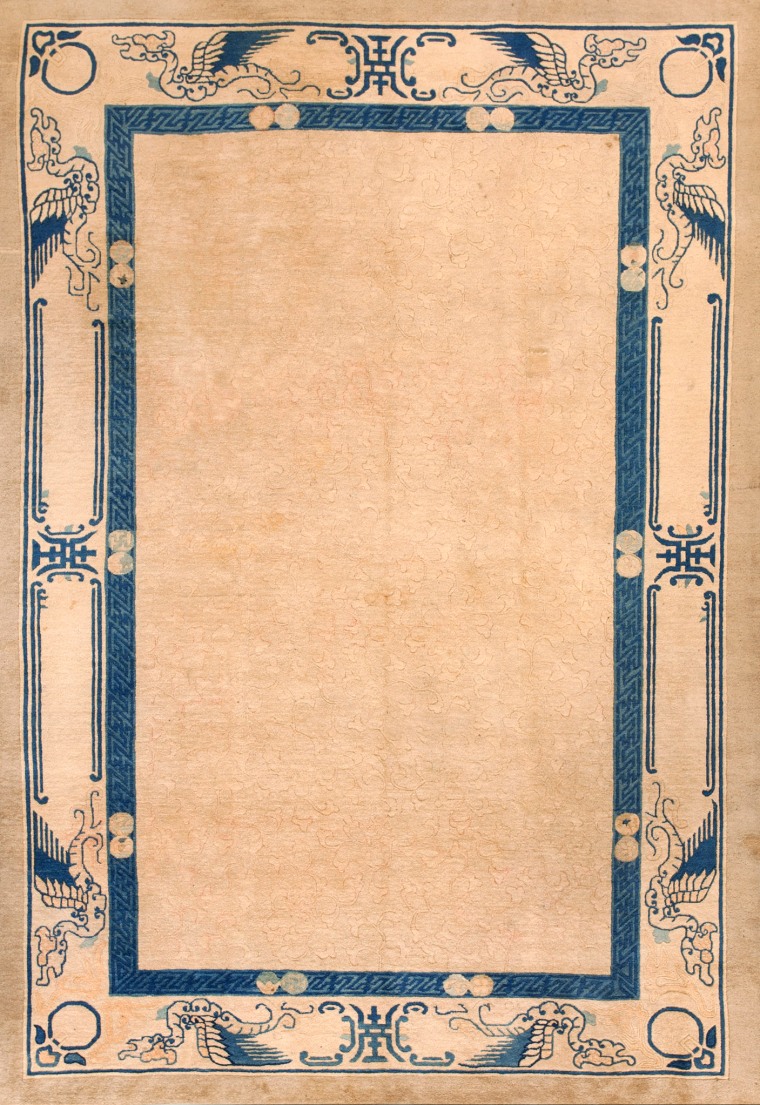
Finally, consider the small, almost secretive dragons as heads emerging from fretwork or vinery. This design convention goes back to at least Han dynasty times on bronzes and on rugs to the seventeenth century. A few examples on Peking antique carpets will suffice: 22837, 22942.
[illustrations of 22837, 22942.]
The dragon is a universal beast, but it first appears in Chinese art and any rug that prominently displays it is likely to be Chinese, most likely a Peking Chinese carpet of the 1880-1940 period. Our collection of these attractive and decorative carpets, so imaginatively rich, is the most comprehensive anywhere. Here there be dragons.
The Whiteley, London | Kelly Behun Studio
As seen in Wallpaper Magazine, Kelly Behun was asked to design the first model residence at The Whiteley – housed in a historic former department store near Hyde Park, London – and reimagined by Foster + Partners Architects into a project comprised of 139 apartments as well as a Six Senses hotel & spa; all a short walk from Hyde Park.



Kelly used Chinese carpets in a few of the spaces – the perfect accompaniment to her punchy and eclectic style. Bold color and reflective surfaces juxtapose soft tones and subtle textures for a cohesive space which communicates harmony through contrast.



The moody sophistication of color rich spaces connect with the peacefully cultured opposition of the living areas - a yin and yang of energies for work and life. Richly subdued colors in the artwork, the accents, and the carpets bridge the two vibes.
Ready to get bold in your home? Here’s a whole pile of comparables for you to bring that Kelly Behun look to your floor.



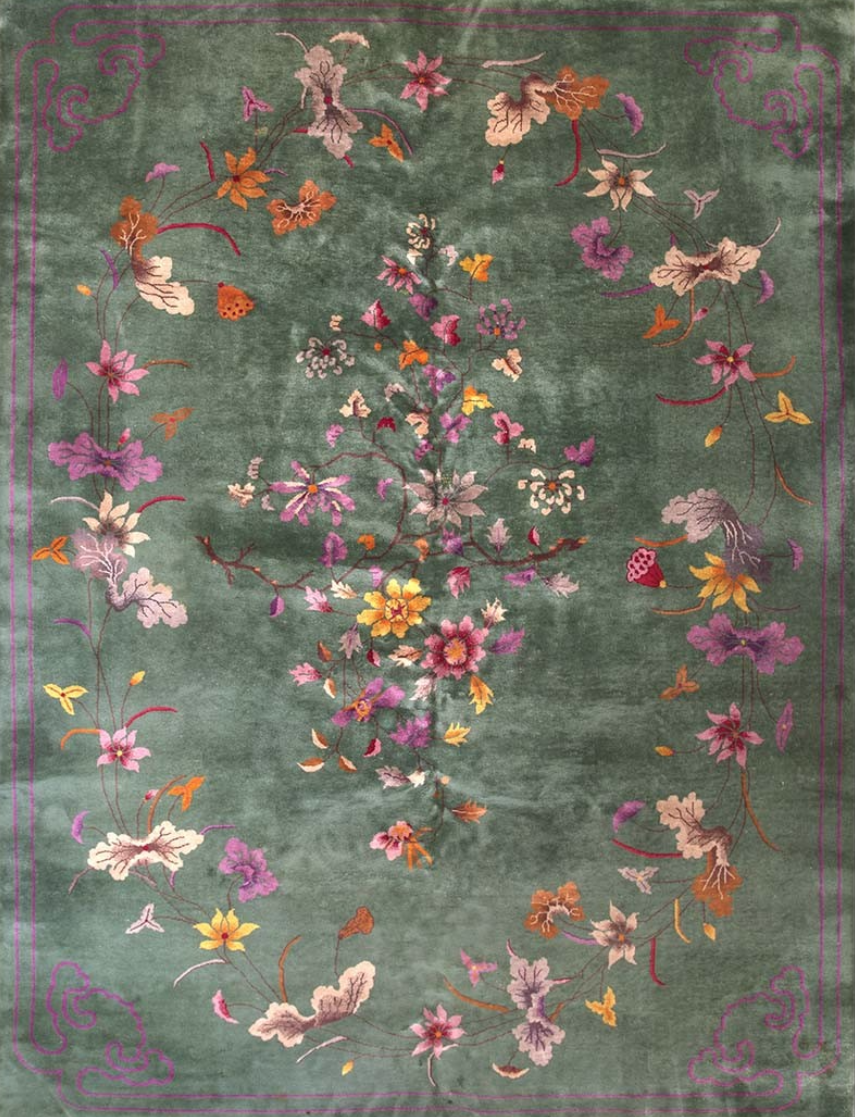
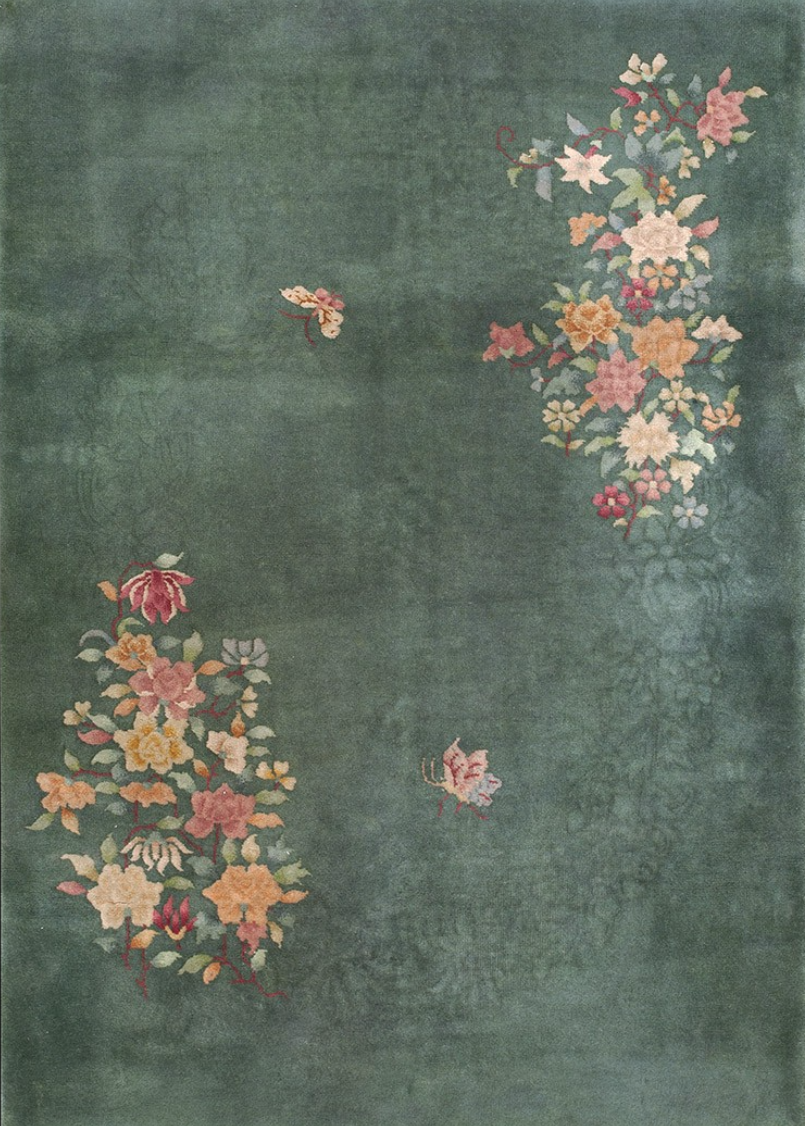




















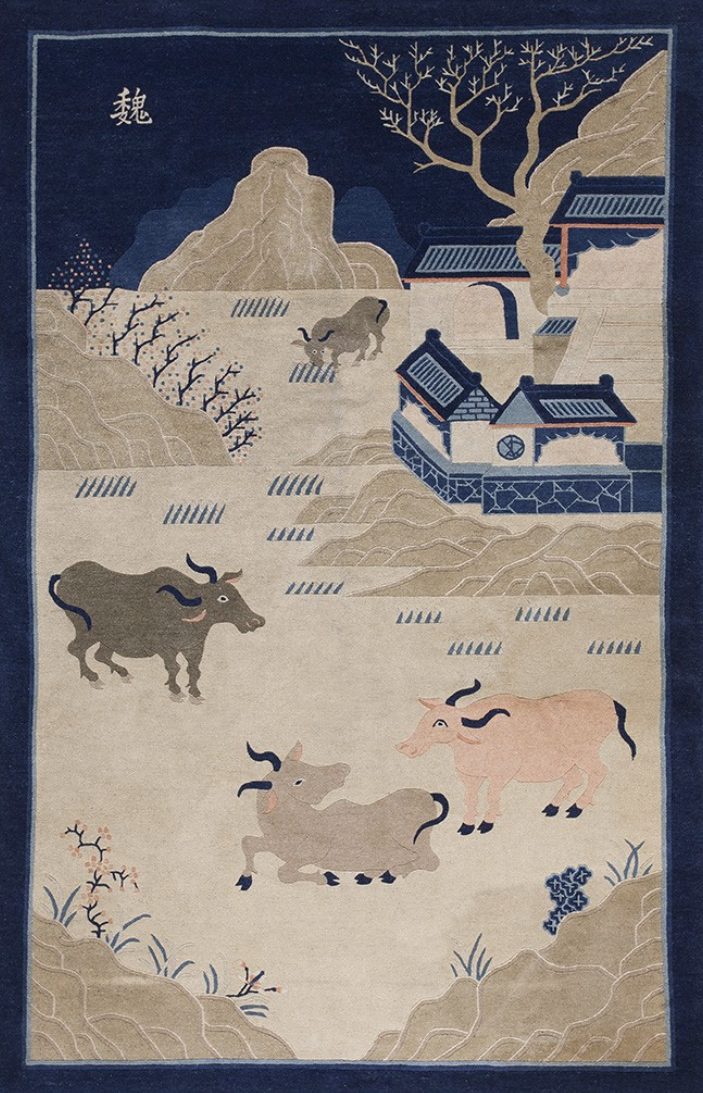







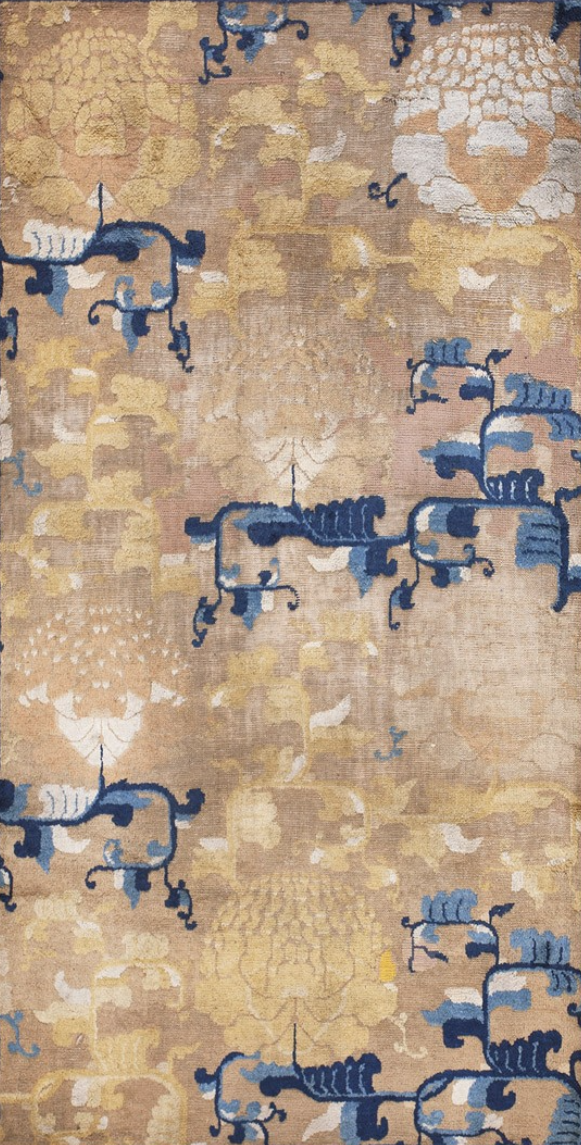

















Contact us when you’re ready. ;)
Mid 19th Century Aubusson of the Studio-Office at L’Ermitage de Pompadour
The studio-office at L’Ermitage de Pompadour is the Fontainebleau home of collector Charles de Noailles, French author and patron of the arts.
The office was decorated by Georges Geffroy (1903/05–1971), who is aptly described by Mitch Owens as “the most glamorous interior designer you’ve never heard of.”
Owens writes in an article in Arch Digest, “In his youth, the Paris-born Geffroy had worked in fashion, turning out hats for Paul Poiret and Redfern and designing clothes at Jean Patou. By the 1930s, though, he had begun decorating, turning out everything from suave fashion-house salons for Jean Piguet and Marcel Rochas to striking theater sets, such as a celebrated production of Sheridan’s School for Scandal, to glamorous, history-inflected rooms for celebrated socialites.”
The pictured studio gives us historical reference for the design and its uses as we present to you a matching mid 19th Century Aubusson carpet from our inventory.
Stock ID 19734
French Aubusson
10’0″ x 16’0″
circa 1840
The extremely fine woven mid-19th century French Aubusson rug was designed by Sallandrouze, who were amongst the wealthiest and most illustrious families in the carpet, rug and tapestry industry in Aubusson.
The piece is rich with silk and gilt-metal thread. An irregular lattice delineates lozenge shaped spaces and is centered on a particularly large and elaborate sub sectioned ivory motif. Each tall panel is filled with arabesques organized in a cruciform pattern. The narrow, off-white check-mark border discreetly frames the whole.
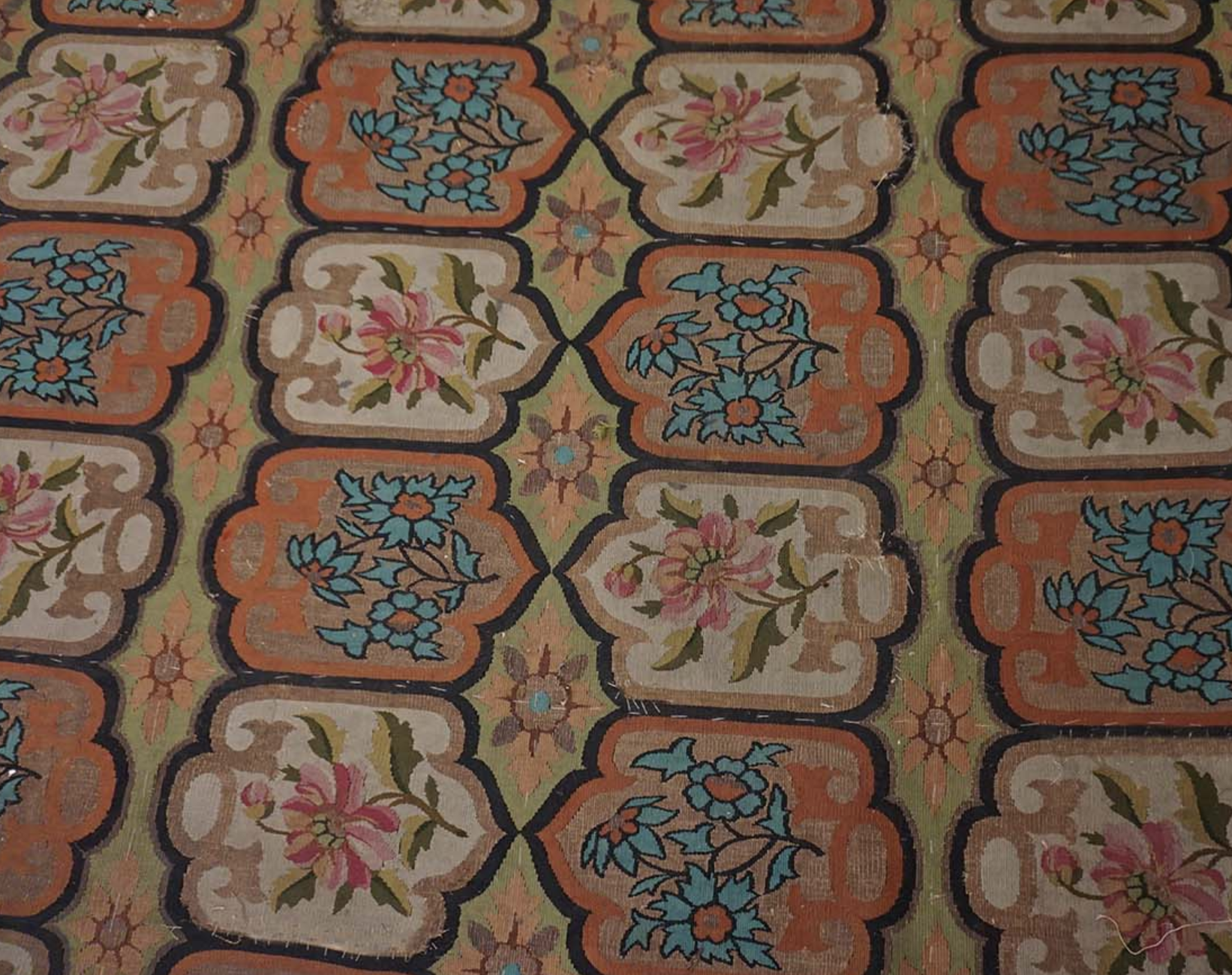


To view the rug on our website click here.
Celebrating Masterworks
It’s no secret that we love working with the spectacular Ryan Lawson, and we’re especially thrilled to see his inspired visions in an exhibition called CELEBRATING MASTERWORKS, in which Ryan uses some of our vintage and antique carpets to help build narratives around the furniture.
With Ryan’s eclectic touch, he pulls from the incredible collections of Dobrinka Salzman and Diner Gallery to curate the best of the best works by a number of artists.
Here an early 20th Century Donegal Arts & Crafts Carpet Designed by Gavin Morton brings an intense warmth that offsets the wall color perfectly.
The “Turkey red” Oushak based design eschews borders, and the whole effect is that of a centered, but not overtly medallion, layout. The color palette is narrow, including red, cream and black. One could see it as a Turkish village yastik (cushion cover) blown up to vast room-size. The weave is quite coarse and the carpets were intended for a middle class clientele, going with wallpaper, furnishings and accessories. They were marketed primarily through Liberty of London. The carpets in this design, as most of Donegals were, came in various colorways, and there are examples with cream and dark blue grounds.
Unlike Oushaks which were produced in quantity, Donegal carpets were woven in smaller numbers and have always been relatively uncommon.
Stock ID 24303
Irish Donegal
11’4” x 16’8”
circa 1900
https://antiquerugstudio.com/donegal-arts-crafts/24303




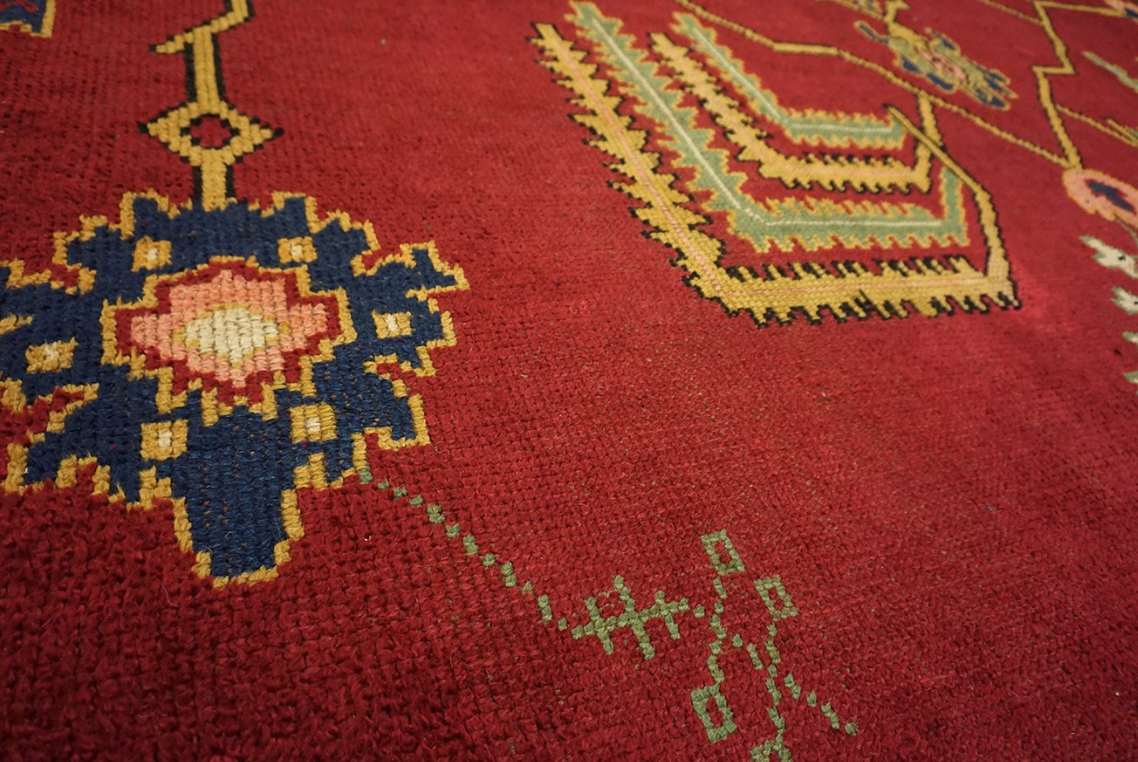



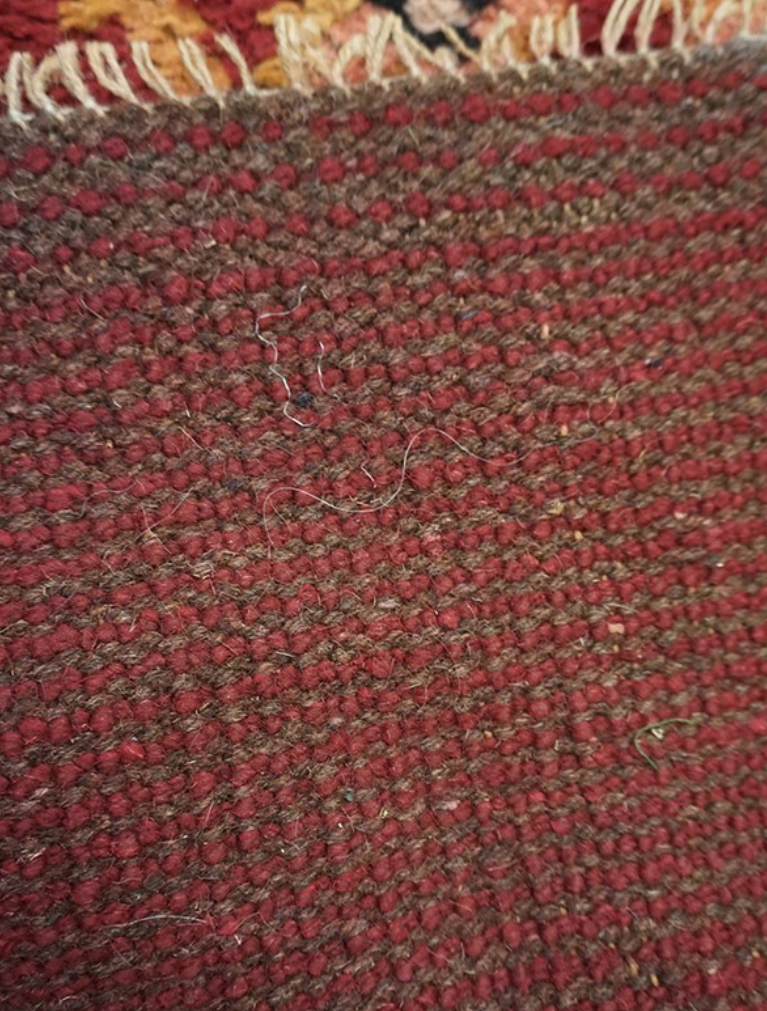
In this ensemble a 1950s Swedish Rya grounds the space with its modern rendition of pictorial tradition that is more than two centuries old.
The relatively shaggy pile is arranged in an oval ecru lattice creating pumpkin yellow – orange reserves, forming a background for stick figures of peasants wielding pitchforks, baskets, staves and slings for seeding. Some could be construed as ancient military figures with shields.
The pictorial tradition in Scandinavian Rya and Rollakan pile and flat-weave, rugs and carpets is more than two centuries old, and in fact probably had an origin back in Mediaeval times.
Stock ID 19728
Swedish Rya
6’6” x 9’9”
circa 1950
https://antiquerugstudio.com/rya/19728









The open light rose field of this 1930s Austrian Art Nouveau Vienna Werkstätte carpet is bounded by a narrow stripe of alternating squares and rectangles. The general effect is minimal yet colorful. The carpet does not have a design in competition with the art and other furnishings, but it easily holds its own in any context.
Stock ID 19280
Austrian Art Deco
9’4” x 13’6”
circa 1930
https://antiquerugstudio.com/art-deco-european/19280






This space features a mid 20th century Ecuadorian carpet designed by Olga Fisch which is an abstracted and minimalist design in neutral tones – inspired by the Nazca Lines of Peru.
The “Nazca Lines” are ancient Peruvian, but they have inspired the drawing on this Moderne New World carpet. The vast majority of Ecuadorian carpets display active, schematic human figures and animals, generally in dark tones contrasting with cream, borderless grounds. This is the only known carpet by this designer executed in a totally abstract, minimalist manner.
Stock ID 24599
Ecuadorian
12’4” x 17’3”
circa 1960
https://antiquerugstudio.com/ecuadorian-/24599



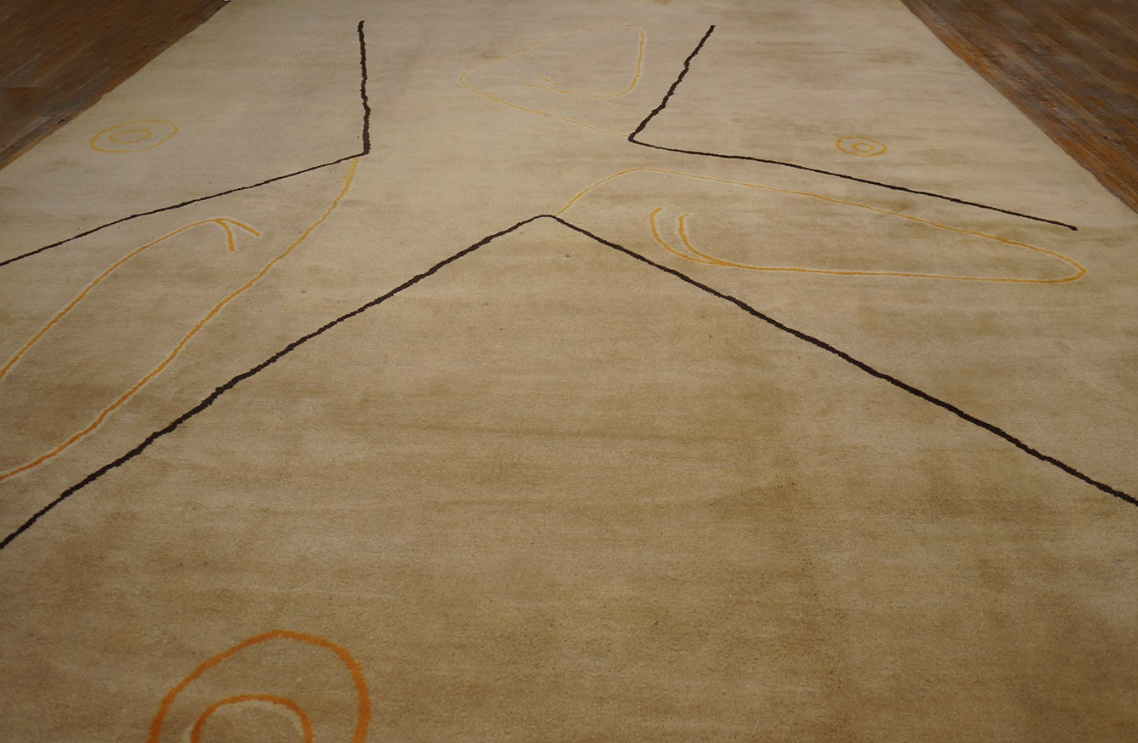





We hope you’ve been inspired by these lovely and eclectic views, and will contact us when you’re ready to act on your inspiration.
Bedroom at Château de Montpoupon
Montpoupon is a fortified castle destroyed during the hundred years war, and rebuilt during the Renaissance by the Prie family. The chateau has been inhabited by the same family since 1857.
An open window illuminates the interior’s history and creates its own atmospheric lighting in this little bedroom.
The dark wood and navy carpet combined exude a moody vibe – which is amplified by the light of the single window.
The space features a NW Persian carpet with an all over boteh design, which is quite incredible to find a pair for – and it just so happens that we have exactly that in our inventory.
Navy combined with softer blues and neutrals make this traditional design a strong, yet easy going choice.
Here’s the goods to make you feel like the King of your own castle:
NW Persian
7’0″ x 11’6″
circa 1850
Check out some detail images to better view the nuances of this mid 19th century masterpiece. The subtle ahbrash of color within the rug is such a compelling feature.



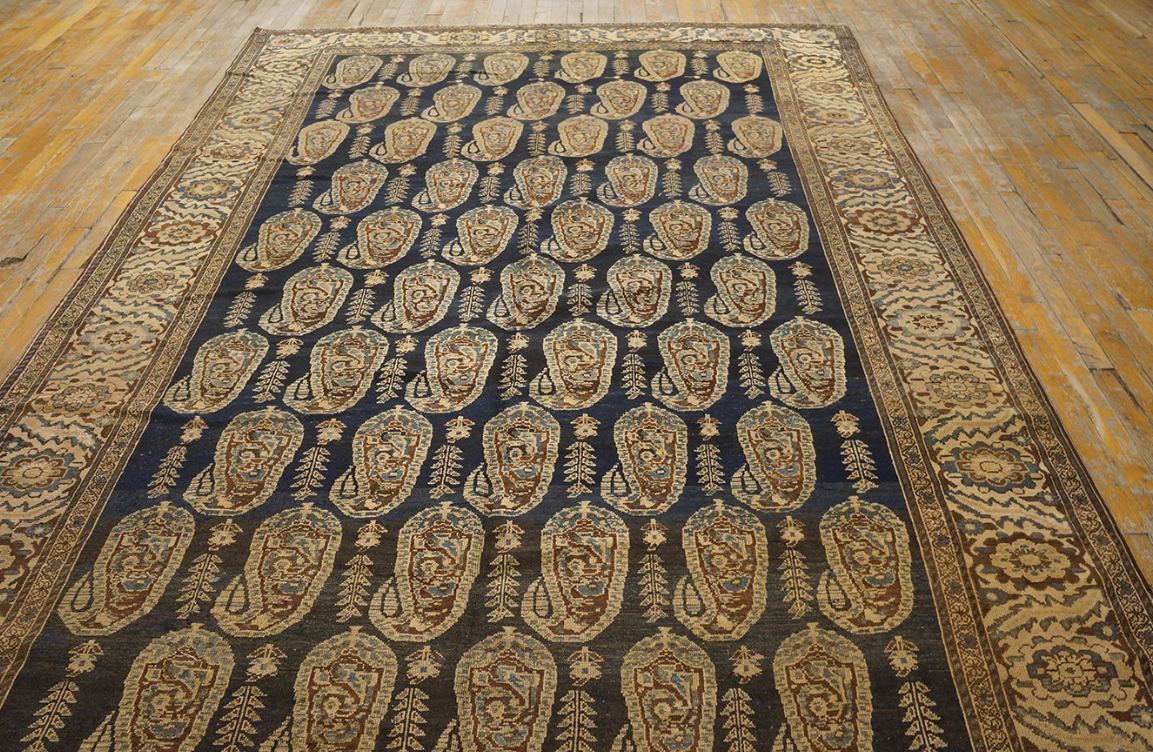




View this carpet on our website, or contact us to see it in person!
Antique Indian Sampler Mat
25670
Indian Sampler Mat
Northern India, possibly Lahore
2.0 x 3.10
C. 1930
All cotton foundation, with approx. 180 asymmetric (Persian) wool knots per square inch
Sampler mats were created for several different purposes: to store patterns; for the weavers to consult when making larger carpets; and for the ultimate client to approve the weave, color way and pattern before a larger carpet is woven.
Indian samplers are quite rare, and they usually function as both weaver guides and pattern reservoirs. This sampler, incorporating a snippet of the ogival red leaf lattice field, with a section of a yellow ochre border with cypresses, trees and upright flowering plants, has not been taken from a Mughal period pashmina pile, silk foundation, ultra-fine weave but from an illustration of one. A fragmentary piece is in the Metropolitan Museum of Art, Ex-Altman collection. These fragments are from a long and narrow carpet with a weave of about 1250 knots per square inch. They were first published with an illustration in Sarre and Trenkwald, Old Oriental Carpets, vol. II, 1926-1929. So, the sampler mat cannot be older than about 1930.
The pile is regular sheep wool rather than fine pashmina goat. The sampler was used in a factory to create a full-sized carpet. Given that it is incomplete in both field and border, there were probably additional samplers with other parts of the design. The colors are, however, modern close approximations of the original.


As to where and by whom the sampler was made. Lahore is the first possibility. This has always been a carpet trading and weaving center. Thus, the rug could have been ordered from any one of the local shops. The sampler was made in a very professional atelier which had access to an extensive design library, one having the Sarre and Trenckwald set. Oriental Carpet Manufacturers (O.C.M) was active in India beginning in the first quarter of the 20th century and had an excellent library and skilled designers. They had a specialized factory in Mirzapur weaving fine carpets, and this sampler could have used these. OCM did not market their carpets and it is difficult to assign any extant pieces to them, but since they were by far the largest carpet manufacturer, it is quite possible that this piece is one of theirs. Historicizing Mughal-style carpets, copied from illustrations in Sarre and Trenkwald , and from Hendley, Carpets in the Jaipur Palaces, 1905-6, were available in the Interwar Period, OCM possessed them in their extensive library, and we have seen other Mughal-style pieces of finer weave that successfully reproduce the originals. This sampler allows us to complete the fragmentary original.
To view this sampler on our website, click here.
*Written by Dr. Peter Saunders.
Mid 19th Century Central Asian NingXia Carpet
24013
Ningxia North Central China
17’10” x 17’10”
C. 1850
Warp: cotton, off white, handspun, Z-4-S
Weft: cotton, off white, handspun, 2 shoots alternating
Pile: wool, 3 strand, handspun
Knot: asymmetric, open left, 48 knots per square inch
Sides: one cord, offwhite cotton wrapped
End: no original finish
This is a particularly large example of a Mandarin official’s carpet with a central medallion displaying nine lion dogs collectively symbolic of success on the national Chin Shih examination which provided guaranteed entry into the national administrative bureaucracy and the wealth devolving therefrom. The nine lion dogs are a rebus for success in the national bureaucracy. The apricot ground features 11 full or partial rows of tree peonies, flower and stem. This carpet is particularly large and clearly was made for a highly placed official or the wealthy family of a recent graduate of whom great things were expected. The principal was probably Buddhist as indicated by the embroidered ball and precious objects in the medallion. The clouds surrounding the lion dogs form a broken, polychrome circle rather than the usual continuous cloud wreath. This is one of the several features indicating a bespoke order rather than a piece made for the market.
Another indicator is the exceptional size, as the standard square Ningxia Mandarin carpet is about 12 to 14 feet square. The main border continues the color combination, with a now apricot ground and peonies among floral arabesques. The blue inner stripe is unusual with butterflies alternating with paired peaches of longevity. Surrounding the whole is a wide, dark blue plain band. The drawing is balanced in all directions, with nothing cut off or left incomplete.
The medallion has three peony rows below and four above, but it seems well centered. To have added another row at the bottom would have been technically more correct, but it would have made the carpet less than square, and squareness was an essential requirement. The notion that these square carpets were made for conforming dais platforms can be dismissed on an even cursory look at traditional Chinese houses. There are no daises. The only dais platforms are in the Forbidden City Imperial throne rooms and this is not an Imperial rug.
The condition is extraordinary. Such carpets were woven for the largest room of the house, the ancestor hall, and brought out only on important occasions like funerals, weddings, visits or holidays. Otherwise, they were rolled up and stored away. The handle is particularly thick and solid, and indicates a turn away from the softer and looser characteristic earlier Ningxia weave. Very few large Ningxia carpets are known and even fewer are in this exceptional state of perfect preservation.
The peony is a traditional Chinese carpet design, but it is usually combined with butterflies, bats, fretwork or other elements. The close and allover display of peonies is very unusual. The flower heads reverse direction at the approximate horizontal middle of the carpet. The carpet was originally more of a lacquer red as indicated by the verso. The logwood dye has, as is usual for Chinese carpets, changed to a mellow apricot.
As is standard, Ningxia carpets are not dated or inscribed, and it would be impossible to ascertain the original patron of the piece. In any case, his dwelling would have been most substantial with an ancestor hall twenty or more feet in width. The intended owner would have been highly placed in any case.
The exact workshop practices of the dozen or so workshops active at the time are not known, but the weavers, Hui Muslims, worked on vertical looms. Whether they employed partial cartoons for this exceptional piece is unknown, but it surely was well supervised. The central medallion probably had some sort of graphic guide, however.






Written by Dr Peter Saunders.
To view this rug on our website, click here.
Rug Swap Fun
Here’s a fun space in London with one of our stunning and punchy antique Chinese Art Deco carpets.
We absolutely adore this space, but, just for fun…
Let’s switch it up and try some other options from our inventory on for size and see how it alters the look.




Everyone’s taste, and interior style is different, and a completely different look can be achieved by simply swapping the rug that grounds your space. Which one of these alternatives is your favorite look?
Whether your look is casual, colorful, formal, or eclectic, we’ve got that something that will be the perfect accompaniment under foot. Check our inventory or let us get a search started for you today.
Fun Find | Tiny Pricks Project
As described on their website, Tiny Pricks started as a public art project created and curated by Diana Weymar. Contributors from around the world began stitching Donald Trump’s words into textiles, creating the material record of his presidency and of the movement against it. Tiny Pricks Project holds a creative space in a tumultuous political climate. The collection counterbalances the impermanence of Twitter and other social media, and Trump’s statements as president through the use of textiles that embody warmth, craft, permanence, civility, and a shared history. The daintiness and integrity of each piece stand in stark contrast to his presidency.











Over time the movement has evolved into an array of political quotes, messages, statements, and opinions, as well as messages of peace, love, and inspiration. The creative process of stitching statements of importance that make us feel something, whatever that may be, continues to expand and grow in fascinating ways.
See more work by this collective of artists on the Tiny Pricks Project instagram page.
Fiber Artist | Breeyn McCarney
We are just loving Breeyn’s unique work. Using a method of embroidery called tambour she builds embellishments onto mesh that jumps off the “hoop” at you.
Tambour embroidery is a traditional technique that utilizes a specialist tool called the tambour hook. This tool is used to quickly create a basic chain stitch and can be very versatile when applying different embellishments, such as beads, sequins, feathers, etc.
With this technique Breeyn builds up three dimensional imagery that is often dark, definitely whimsical, and connects with story, myth, and symbolism.







Want to see more of her work? Check her instagram page @breeynmccarney
*all images copyright Breeyn McCarney.
Fun Find | Ramazan Can – To Feel at Home
After viewing the half-neon half-carpet works of Ramazan Can, Rahul Kumar remarks, “I was drawn to the works of Can at the gallery Anna Laudel’s presentation at Art Dubai 2022. A tapestry that I was later told is an original, used piece that belonged to the family of Can, was juxtaposed with neon lights, outlining some of the patterns of the carpet itself. The work was dichotomous – old and new, quiet and bold, handmade and industrial – all at once.”
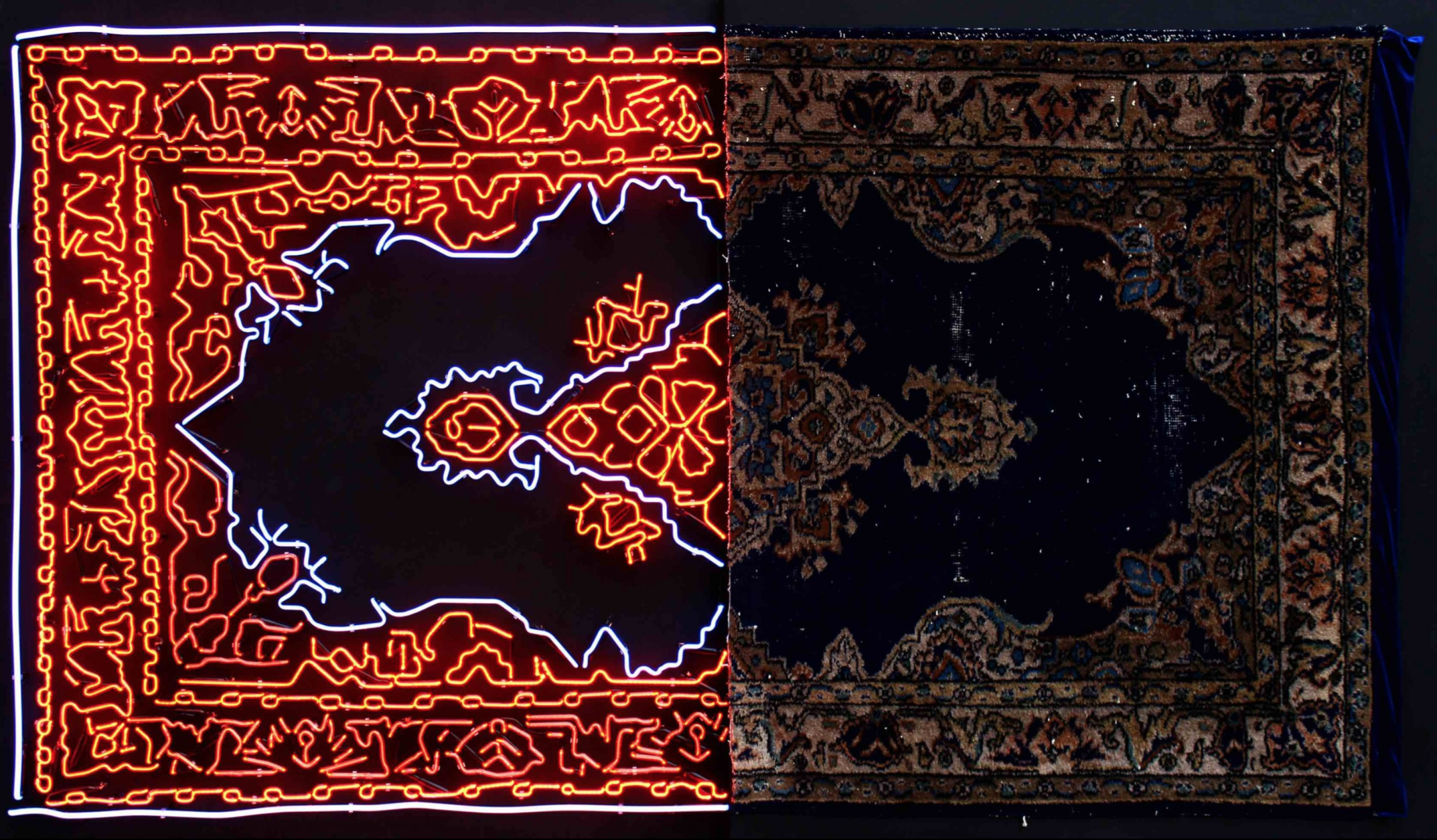





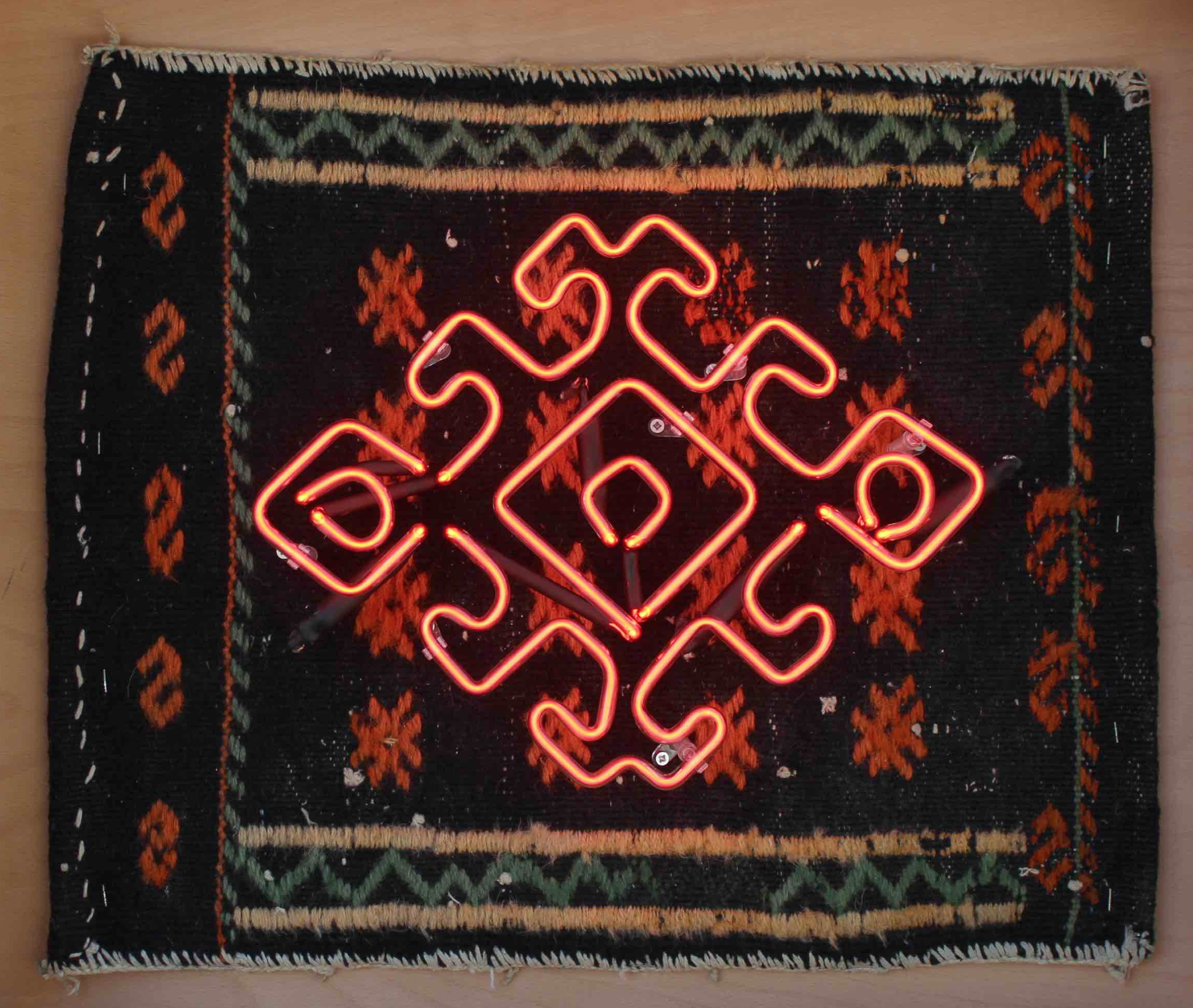

He later interviewed the artist to discuss his work and personal history even further. As stated by Can, in an attempt to deal with the temporal flow of the act of extinction (past-present) and from the opposite (present-past) such half-carpet half-neon works emerged.
My personal favorite of this series is “Always Waited for Tomorrow”. There’s something about the juxtaposition of old and new is incredibly compelling as is, but adding the ‘loading’ bar connects it even more to the idea of temporal flow between past and present.
If you’d like to go more in depth behind the art, the interview by Rahul Kumar is very informative.
*All photos copyright Ramazan Can.
